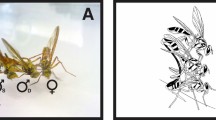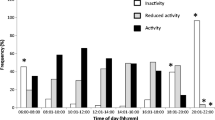Abstract
We examined the influence of male size on the mating success of both wild and laboratory populations of the Mediterranean fruit fly (medfly) Ceratitis capitata. Laboratory females selected larger males even when smaller males were present in large proportions (5:1), although this phenomenon did not occur when the proportion was extended to 10:1. Wild females were observed to prefer wild males over laboratory-reared ones independent of their respective sizes, and wild males of different sizes were found to transfer similar quantities of sperm to the spermathecae of the females.



Similar content being viewed by others
References
Alcock J, Gwynne DJ (1991) Evolution of insect mating systems: the impact of individual selectionist thinking. In: Bailey WJ, Ridsdill-Smith J (eds) Reproductive behaviour of insects: Individuals and populations. Chapman & Hall, London, pp 10–41
Aluja M, Norrbom AL (2001) Fruit Flies (Tephritidae): Phylogeny and evolution of behavior. CRC Press, Boca Raton, Florida
Aluja M, Rull J, Sivinski J, Trujillo-Rodriguez G, Pérez-Staples D (2009) Male and female condition influence mating performance and sexual receptivity in two tropical fruit flies (Diptera: Tephritidae) with contrasting life histories. J Insect Physiol 55:1091–1098
Anderson M (1994) Sexual selection. Princeton University Press, Princeton, NJ
Anjos-Duarte CS, Costa AM, Joachim-Bravo IS (2010) Sexual behaviour of the Mediterranean fruit fly (Diptera: Tephritidae): the influence of female size on mate choice. J Appl Entomol 1:1–7
Arita LH, Kaneshiro KY (1988) Body size and differential mating success between males of two populations of the Mediterranean fruit fly. Pac Sci 42:173–177
Arita LH, Kaneshiro KY (1989) Sexual selection and lek behavior in the Mediterranean fruit fly, Ceratitis capitata (Diptera: Tephritidae). Pac Sci 43:135–143
Beeler AE, Rauter CM, Moore AJ (2002) Mate discrimination by females in the burying beetle Nicrophorus orbicollis: the influence of male size on attractiveness to females. Ecol Entomol 27:1–6
Blanckenhorn WU, Reusch T, Mtihlhauser C (1998) Fluctuating asymmetry, body size and sexual selection in the dung fly Sepsis cynipsea—testing the good genes assumptions and predictions. J Evol Biol 11:735–753
Blay S, Yuval B (1997) Nutritional correlates of reproductive sucess of male mediterranean fruit flies (Diptera: Tephritidae). Anim Behav 54:59–66
Bonduriansky R, Rowe L (2003) Interactions among mechanisms of sexual selection on male body size and head shape in a sexually dimorphic fly. Evolution 57:2046–2053
Bressan S (1995) Desenvolvimento e potencial reprodutivo de macho de Anastrepha spp. (Diptera, Tephritidae) em condições naturais. Rev Bras Ent 39:849–854
Cayol JP (2000) Changes in sexual behavior and in some life history traits of tephritid species caused by mass-rearing processes. In: Aluja M, Norrbom A (eds) Fruit flies (Tephritidae): Phylogeny and evolution of behavior. CRC Press, Boca Raton, pp 843–860
Cayol JP, Vilardi J, Rial E, Vera MT (1999) New indices and method to measure the sexual compatibility and mating performance of Ceratitis capitata (Diptera: Tephritidae) laboratory-reared strains under field cage conditions. J Econ Entomol 92(1):140–145
Christenson LD, Foote RH (1960) Biology of fruit flies. Annu Rev Entomol 5:171–192
Costa AM, Anjos-Duarte CS, Roriz AK, Dias VS, Joachim-Bravo IS (2012) Male diet and influence to inhibit female remating in Ceratitis capitata (Diptera: Tephritidae). J Appl Entomol 136(6):456–463
Churchill-Stanland C, Stanland R, Wong TY, Tanaka N, McInnis DO, Dowell RV (1986) Size as a factor in the mating propensity of the Mediterranean Fruit flies, Ceratitis capitata (Diptera, Tephritidae), in the laboratory. J Econ Entomol 79:614–619
Dukas R (2005) Learning affects mate choice in female fruit flies. Behav Ecol 57:800–804
Fedorka KM, Mousseau TA (2002) Nuptial gifts and the evolution of male size. Evolution 56:590–596
Féron M (1962) L’instinct de reproduction chez la mouche Mèditerranèenne dês fruits Ceratitis capitata Wied. (Diptera Trypetidae). Comportemont sexuel. - Comportement de ponte. Rev Pat Veg Entomol Veg 41:1–129
Fox CW, Czesak ME (2006) Selection on body size and sexual size dimorphism differs between host species in a seed-feeding beetle. J Evol Biol 19:1167–1174
Helinski MEH, Harrington LC (2011) Male mating history and body size influence female fecundity and longevity of the dengue vector Aedes aegypti. J Med Entomol 48(2):202–211
Hendrichs J, Franz G, Rendon P (1995) Increased effectiveness and applicability of the sterile insect technique through male-only releases for control of Mediterranean fruit flies during fruiting seasons. J Appl Entomol 119:371–377
Hendrichs J, Robinson AS, Cayol JP, Enkerlin W (2002) Medfly areawide sterile insect technique programs for prevention, suppression or eradication: The importance of mating behavior studies. Fla Entomol 85:1–13
Höglund J, Alatalo R (1995) Leks. Princeton University Press, Princeton
Hunt MK, Crean CS, Wood RJ, Gilburn AS (1998) Fluctuating asymmetry and sexual selection in the Mediterranean fruit fly (Diptera: Tephritidae). Biol J Linn Soc 64:385–396
Joachim-Bravo IS, Zucoloto FS (1998) Performance and feeding behavior of Ceratitis capitata: comparison of a wild population and laboratory population. Entomol Exp Appl 87:67–72
Joyce AL, Bernal JS, Vinson SB, Lomeli-Flores R (2009) Influence of adult size on mate choice in the solitary and gregarious parasitoids. Cotesia marginiventris and Cotesia flavipes. J Insect Behav 22:12–28
Kaspi R, Mossinson S, Drezner T, Kamensky B, Yuval B (2002) Effect of larval diet on development rates and reproductive maturation of male and female Mediterranean fruit flies. Physiol Entomol 27:29–38
Kaspi R, Taylor PW, Yuval B (2000) Diet and size influence sexual advertisement and copulatory success of males in Mediterranean fruit fly leks. Ecol Entomol 25:1–6
Knipling EF (1955) Possibilities of insect control or eradication through the use of sexual sterile males. J Econ Entomol 48:459–462
Krebs JR, Davies NB, (1996) Introdução a ecologia comportamental. Ed. by Editora Atheneu, São Paulo
Lance DR, McInnis DO, Rendon P, Jackson CG (2000) Courtship among sterile and wild Ceratitis capitata (Diptera: Tephritidae) in field cages in Hawaii and Guatemala. Ann Entomol Soc Am 93(5):1179–1185
Liquido NJ, Cunningham RT, Nakagawa S (1990) Hosts plants of the Mediterranean fruit fly (Diptera: Tephritidae) on the Island of Hawaii (1949–1985 survey). J Econ Entomol 83:1863–1868
Orozco D, Lopez RO (1993) Mating competiveness of wild and laboratory mass-reared medflies: Effect of male size. In: Aluja M, Liedo P (eds) Fruit flies: Biology and management. Springer, NY, pp 185–188
Papadopoulos NT, Katsoyannos BI, Kouloussis NA, Economopoulos AP, Carrey JR (1998) Effect of adult age, food, and time of day on sexual calling incidence of wild and mass-reared Ceratitis capitata males. Entomol. Exp. Appl 89:175–182
Prokopy RJ, Roitberg BD (1984) Foraging behavior of true fruit flies. Am Sci 2:39–49
Rodriguero MS, Vilardi JC, Vera MT, Cayol JP, Rial E (2002a) Morphometric traits and sexual selection in medfly (Diptera: Tephritidae) under field cage conditions. Fla Entomol 85:143–149
Rodriguero MS, Vera MT, Rial E, Cayol JP, Vilardi JC (2002b) Sexual selection on multivariate phenotype in wild and mass-reared Ceratitis capitata (Diptera: Tephritidae). Heredity 89:480–487
Segura D, Petit-Marty N, Sciurano R, Vera T, Calcagno G, Allinghi A, Cendra PG, Cladera J, Vilardi J (2007) Lekking behavior of Anastrepha fraterculus (Diptera: Tephritidae). Fla Entomol 90:154–162
Shelly TE, McInnis DO, Pahio E, Edu J (2004) Aromatherapy in the Mediterranean fruit fly (Diptera: Tephritidae): sterile males exposed to ginger root oil in prerelease storage boxes display increased mating competitiveness in field-cage trials. J Econ Entomol 97(3):846–853
Silva-Neto AM, Dias VS, Joachim-Bravo IS, (2012a) Comportamento reprodutivo de Ceratitis capitata Wiedemann (Diptera: Tephritidae): Efeito do tamanho dos machos sobre o seu sucesso de cópula. EntomoBrasilis (Vassouras)
Silva-Neto AM, Santos TRO, Dias VS, Joachim-Bravo IS, Benevides LJ, Benevides CMJ, Silva MVL, Santos DCC, Virgínio J, Oliveira GB, Walder JMM, Paranhos BAJ, Nascimento AS, (2012b) Mass-rearing of Mediterranean fruit fly using low-cost yeast products produced in Brazil. Scientia Agricola 69(6)
Taylor PW, Yuval B (1999) Postcopulatory sexual selection in Mediterranean fuit flies: advantages for large and protein-fed males. Anim Behav 58:247–254
Taylor PW, Kaspi R, Yuval B (2000) Copula duration and sperm storage in Mediterranean fruit flies from a wild population. Physiol Entomol 25:94–99
Thornhill R, Alcock J (1983) The evolution of insect mating systems. Harvard University Press, Cambridge
Whittier TS, Nam FY, Shelly TE, Kaneshiro KY (1994) Male courtship success and female discrimination in the Mediterranean fruit fly (Diptera: Tephritidae). J Insect Behav 7:159–170
Yuval B, Kaspi R, Shloush S, Warburg MS (1998) Nutritional reserves regulate male participation in Mediterranean fruit fly leks. Ecol Entomol 23:211–215
Yuval B, Maor M, Levy K, Kaspi R, Taylor P, Shelly T (2007) Breakfast of champions or kiss of death? Survival and sexual performance of roteinfed, sterile Mediterranean fruit flies (Diptera: Tephritidae). Fla Entomol 90:115–122
Zamudio KR, Huey RB, Crill WD (1995) Bigger isn’t always better: body size, developmental and parental temperature and male territorial success in Drosophila melanogaster. Anim Behav 49:671–677
Zucoloto FS (1987) Feeding habits of Ceratitis capitata: can larvae recognize a nutritional effective diet? J Insect Physiol 33:349–353
Acknowledgements
We thank CNPq (Conselho Nacional de Desenvolvimento Científico e Tecnológico) for the finantial support granted to the first author.
Author information
Authors and Affiliations
Corresponding authors
Rights and permissions
About this article
Cite this article
de Aquino, J.C., Joachim-Bravo, I.S. Relevance of Male Size to Female Mate Choice in Ceratitis capitata (Diptera: Tephritidae): Investigations with Wild and Laboratory-Reared Flies. J Insect Behav 27, 162–176 (2014). https://doi.org/10.1007/s10905-013-9410-8
Revised:
Accepted:
Published:
Issue Date:
DOI: https://doi.org/10.1007/s10905-013-9410-8




